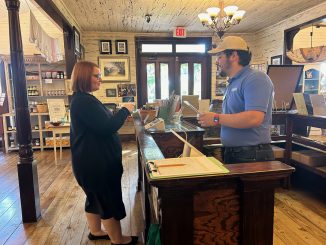
Past Times by Terry Jones
Alligator numbers have exploded in the last 25 years, but for some reason attacks on humans are extremely rare in this state.
In fact, it is claimed that Louisiana has never experienced a fatal gator attack, but that may be incorrect.
A 1774 coroner’s inquest at the French outpost of Fort St. Jean Baptiste in Natchitoches concluded that an alligator killed one of the area residents.
About 7 a.m. on August 10, a slave woman informed coroner Jacques de la Chaise that there was a nude body lying on the bank of Red River (modern-day Cane River).
De la Chaise, Father Vitry, and a handful of other men went to the river and found the body of Jacques du Bois, the fort’s blacksmith, lying half in the water.
De la Chaise wrote in his coroner’s report, “We found near the ear, three wounds equally distant from [illegible]. In addition to this, we found the eyes bulging and unusually swollen. We did not notice any other wound on the rest of the body, which led us to believe an alligator had attacked him while he was bathing, since we found the body nude.”Whenever someone died at Fort St. Jean Baptiste, it was customary to inventory all of their possessions. If there was no heir, the local people were called to the fort by a series of drum rolls for a public auction of the goods.
Jacques du Bois was a bachelor who lived in a single room supplied by his employer, fort commandant Louis Juchereau de St. Denis.
His property inventory provides a glimpse of what a working-class bachelor possessed in colonial Louisiana.
Stored in a small locked chest were two shirts and a pair of pants (all described as being “half worn out”), a coat, four pairs of stockings worn out at the feet, an old cap lining, a pair of linen pants, a “worn-out” tie, and a promissory note for 58 livres, signed by a soldier nicknamed La Fleur (“the flower”), of which 35 livres were still due.
Elsewhere in the room, the officials recorded the following:
Two worn-out shirts
A worn-out linen suit
An old knife with a deer horn handle
An old handkerchief
A pair of Spanish garters
A suit of thick cloth
A small, faded blacksmith’s apron
A half worn-out hat
An old waistcoat
Two leather pillows
Two old leather aprons
A worn-out cap lining
Two glass bottles
A davit (a crane-like device used to hoist cargo onto a ship)
An old open mirror
Two bad pairs of shoes with an old pair of steel buckles
A powder gun with a powder horn
A bad cap made of platille
Two bad barrels from saddle pistols
An iron tobacco box
A coat and breeches made of ticking
An Indian basket
Two old Indian jars
A bunch of onionsThe worn-out clothing and meager belongings indicate Jacques du Bois was not a man of much means. Nonetheless, his fellow settlers came to the fort when the public auction was held and snatched up everything.
In all, the auction brought in 116 livres, and the money was used to pay off the blacksmith’s debts. Included was a debt of a little more than 11 livers that Du Bois owed for milk (the document’s literal translation has the debt being owed to the cows themselves).
Father Vitry was paid 9 francs for burying du Bois, the fort’s drummer received 3 francs for announcing the auction, the fort’s clerk was paid 3 francs for removing the body from the river bank, and just over 8 francs were used to pay for inventory and auction expenses.
Although we cannot be certain what caused Jacques du Bois’ death, if an alligator did kill him that hot August morning, he must have been the unluckiest Louisianian ever to go skinny dipping.
Du Bois is the only person in more than 300 years of recorded Louisiana history whose death was officially attributed to an alligator.




Be the first to comment